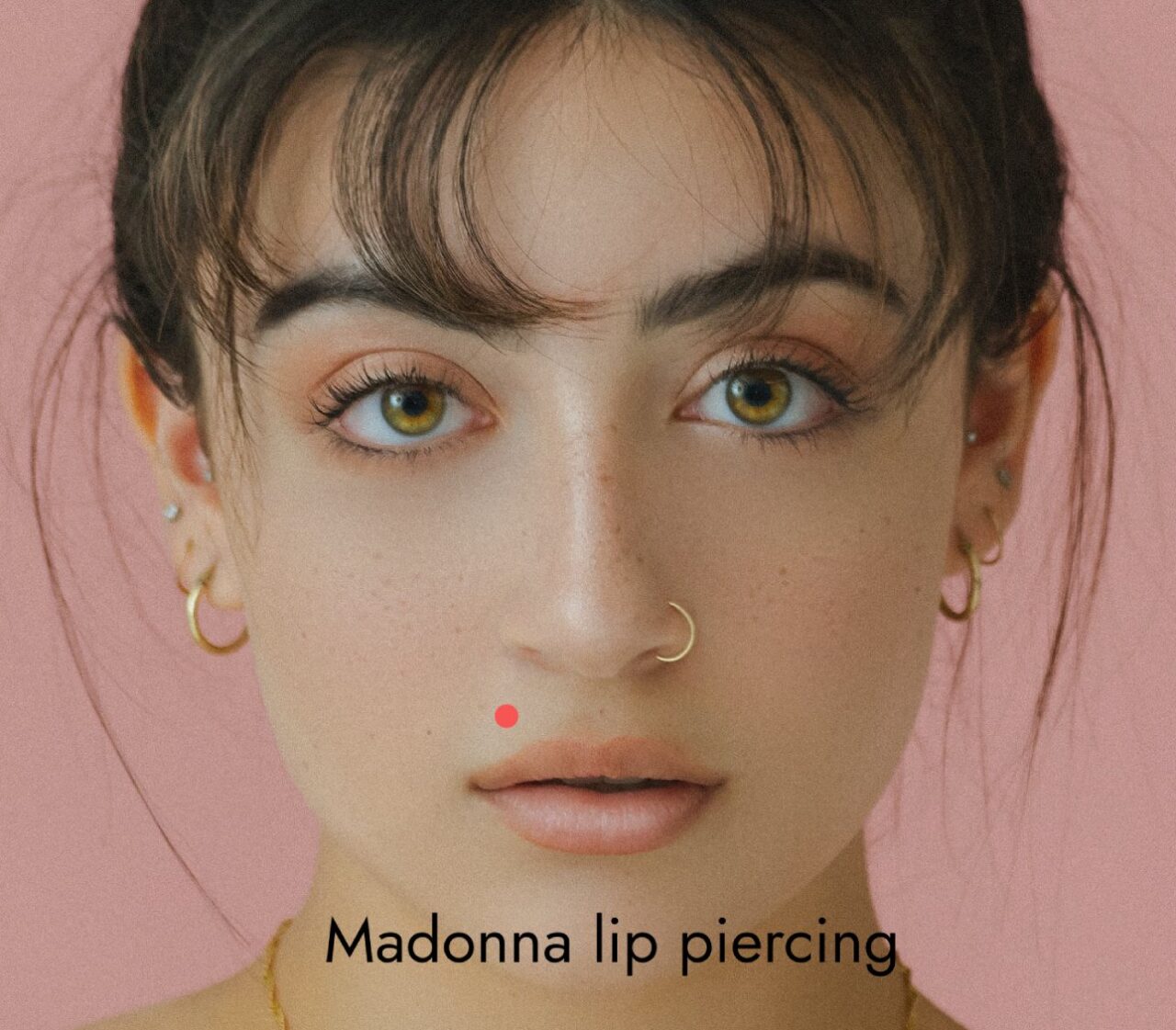Monroe Piercing: Pain, Cost, Healing Time, Jewelry, Sizes, Aftercare

A Monroe piercing is a great way to showcase your personality and style. Whether you're interested in getting any piercing for self-expression or culturally significant reasons, it's important to understand the risks involved.
Here, we will delve further into this popular piercing style so you know what to expect and how you can facilitate the healing process.

What Is a Monroe Piercing?
A Monroe piercing is nearly as iconic as the actress it is named after. Monroe piercings lie on the left side of the face, just above the upper lip. This piercing is more prevalent among women. However, some men also enjoy the provocative look it creates.

Variant: Vertical Monroe Piercing?
A vertical Monroe piercing is a lip piercing combining the aesthetics of a Monroe with a traditional labret piercing. For this look, the Monroe piercing is positioned above the top lip, while the labret piercing lies below the lower lip. This placement creates a unique and striking vertical alignment.
Madonna Piercing vs Monroe Piercing

The primary difference between Monroe and Madonna piercings is which side of the face they are on. A Monroe piercing is placed off-center from the lip on the left-hand side, emulating Marilyn Monroe's beauty mark.
The Madonna piercing is similar. However, it is placed above the upper lip on the right side of the face and mimics Madonna's beauty mark.
How Much Are Monroe Piercings?
Usually, a Monroe piercing costs between $50 and $80, depending on the piercing parlor and jewelry chosen. Instead of choosing the least expensive option, you should always shop around and locate an experienced and highly recommended piercing professional.
Never select a piercer who uses a piercing gun, as these tools may harbor bacteria.
Monroe Piercing Pain
Does a Monroe piercing hurt? Most upper lip piercings are mild to moderate on the pain scale. Some people report feeling a sharp, stinging sensation during the process. You'll likely feel some pain because your lips have more nerve endings than your nose or ears.
However, the amount of pain you experience depends on your tolerance and the skill level of your piercer.
Monroe Piercing Healing Time
How long does a Monroe piercing take to heal? Monroe piercings heal relatively quickly and usually depend on how well you follow an aftercare routine. In general, a Monroe piercing heals within 8 to 12 weeks.
However, some may take as long as twelve weeks to heal properly.
Monroe Piercing Healing Stages
Healing time for Monroe piercings is between 8 to 12 weeks. Because part of the piercing lies inside your mouth, you must rinse it with a saline solution or mouthwash after each meal to prevent bacteria from becoming trapped inside.
If your lip piercing heals without complications, you can expect the following stages to occur:
Week 1
Some swelling around the piercing site, soreness, redness, and bleeding are expected during the first week of healing.
Week 2
By this point, most pain and bleeding around the area should stop, and any swelling or redness should subside.
Week 3
The swelling should be minimal at this point, and you may see lymph fluid form around the piercing site. This fluid is clear to whitish and is not pus. Therefore, it is not a cause for concern. Instead, it's a sign your piercing is properly healing.
Weeks 4 Through 6
While your piercing may appear fully healed on the outside, it is still healing on the inside. Therefore, it's vital to keep up your aftercare routine.
Monroe Piercing Jewelry

Cute Monroe piercing with natural gemstones titanium 16G $24.9, SHOP NOW.
Labret studs are specifically designed for lip piercings. For your Monroe piercing, use the same gauge size your piercer used for your initial piercing. If you use a smaller gauge, the piercing hole may shrink around it, even once it's healed.
The portion of a labret stud you can see is called a "top," and it is measured in millimeters. If you prefer a smaller, more subtle Monroe piercing, aim for tops measuring one to two millimeters and featuring small rhinestones or metallic balls.
If you prefer a more dramatic, eye-catching appearance, aim for options that are three millimeters or larger.
Monroe Piercing Jewelry Sizes
What Gauge Is a Monroe Piercing?
Gauges measure the diameter of Monroe piercings. The standard gauge piercers used for a Monroe piercing is 16 gauge (equivalent to 1.2 millimeters), although your piercer may also use 14 gauge (equivalent to 1.6 millimeters).
Length
The length usually ranges from 1/4 inch (6mm), 5/16 inch (8mm), and 3/8 inch (10mm). The thickness of your lip often influences the length of your first labret.
Usually, the initial jewelry your piercer will use for a Monroe piercing has a longer post. Professional piercers use longer posts to make room for the swelling that usually follows after a fresh piercing.
As your swelling decreases, you will likely notice your post looks longer. At this point, you can make an appointment with your piercer, and they can help you downsize to a smaller labret post for a fitted look.
Metals for Monroe Piercing Jewelry
Generally speaking, high-quality jewelry made from titanium or surgical steel is less likely to cause allergies or irritate your skin.
1. Implant-Grade Titanium

Flat back stud with a ball titanium 14G 16G $18.9, SHOP NOW.
Implant-grade titanium Monroe piercing jewelry is strongly recommended. It is lightweight, nickel-free, and won’t tarnish. It’s often recommended for those who are allergic to brass, nickel, and other metals common for jewelry.
2. Precious Metals
Platinum and 14-karat gold lip piercing jewelry can offer an elevated look. However, they may be more pricey and could tarnish over time. Also consider if you have allergies, such as an allergy to gold.
3. Surgical-Grade Stainless Steel
If you opt for stainless steel, you should opt for surgical-grade steel. It often contributes to a smooth healing process and is extremely durable. However, even surgical steel can contain small amounts of nickel that could cause allergic reactions in those with skin sensitivities.
Talk through all material options with your piercer to figure out what’s best for you and your skin.
Are There Any Risks With Monroe Piercings?
All lip piercings pose some risk to oral health, with some piercing sites being riskier than others. A Monroe piercing may be more likely to cause damage to the soft tissue inside your mouth. This risk is due to your jewelry moving against the gums, causing irritation and potential complications.
Jewelry featuring a back disk may also cause gum recession or damage your tooth enamel. If you are concerned about developing these complications, a labret stud may minimize these problems.
What Should I Do if It Becomes Infected or Swollen?
Contact your doctor or piercer immediately if you notice signs of infection or swelling extending beyond the piercing site. Wait to remove the jewelry until you receive professional guidance, as removal may trap bacteria, allowing the infection to spread.
Your piercer or medical professional may advise you to cleanse the area with a saline solution or apply a warm compress to minimize irritation and decrease swelling.
Monroe Piercing Aftercare
- Opt for soft foods that aren’t overly spicy or acidic.
- Chew very carefully to avoid biting your lip jewelry.
- Avoid strenuous activities with your mouth until your piercings are fully healed.
- Avoid mouthwash with alcohol.
- Take care to avoid contaminating the piercing.
- Avoid touching it or applying makeup very close to it.
- Avoid getting in the water that might be dirty.
- Clean your piercing twice per day using a saline solution made for wound cleaning or soap and water to prevent infection.
- Avoid ointments as they prevent necessary air circulation.
- And of course, make sure to avoid snagging on clothes or towels.
- Wear loose clothing. Avoid wearing tight clothing or clothing that may rub against the piercing, as this can cause irritation and slow down the healing process.
- Use hypoallergenic jewelry like implant-grade titanium and 14- or 18-karat gold. Surgical-grade steel may contain small amounts of nickel that could cause allergic reactions.
- Don't move the piercing unless you're cleaning it. Pulling on a piercing early in healing is painful, but it also can get in the way of healing or damage the piercing itself.
- Wait until your piercing heals before changing out your jewelry.
- Watch for potential signs of infection and consult your piercer or doctor if it becomes infected.
Once your piercings are fully healed, you’ll be able to resume most of your daily habits. However, you may still find it difficult to eat certain foods or drink certain beverages that irritate the wounds. Be sure to talk with your piercer about concerns you may have.
Cleaning
- It is recommended to use sterile saline that you buy from the store, rather than homemade saline, for cleaning your piercings. Homemade saline may be too salty for delicate piercing sites, leading to dryness and delayed healing.
- Using mild, fragrance-free soap and water to clean your piercing site is also an option.
- If you prefer homemade salt solution. You can start by mixing 1/2 teaspoon of non-iodized salt with one cup of distilled or boiled (for at least 20 minutes) water. You may choose to use less of the salt mixture like 1/4 to 1/8 teaspoon if you want a weaker solution that’s less likely to burn or sting. Stir the solution until it dissolves.
- If you see signs of infection, you can also use antiseptic solutions, such as betadine, isopropyl alcohol, or diluted hydrogen peroxide. However, avoid using them for daily cleaning as they can damage cells.
- Soak a cotton ball in the solution and dab it around the piercing site. Don't remove the jewelry!
- Take clean gauze or tissue and pat the area dry.
Your piercer should give you detailed instructions on how to keep your piercing clean once it has been placed.
To Conclude
Before receiving any piercing, it's essential to research the potential side effects and complications. By choosing your piercer carefully and adhering to aftercare guidance, you can minimize risks and enjoy your new piercing for many years to come.
Read More
Madonna Piercing: Everything That You Need to Know
What Is a Labret Piercing? Types, Pain, Cost, Healing, Jewelry, Sizes, and Aftercare
What’s an Ashley Piercing: Healing, Pain, Cost, Jewelry, Pros, and Cons
Snake Bite Piercing: Cost, Healing, Pain, Meaning, Jewelry, and Aftercare

















